Roots of rest
Conservation cemeteries provide a deeply personal, nature-connected approach to death
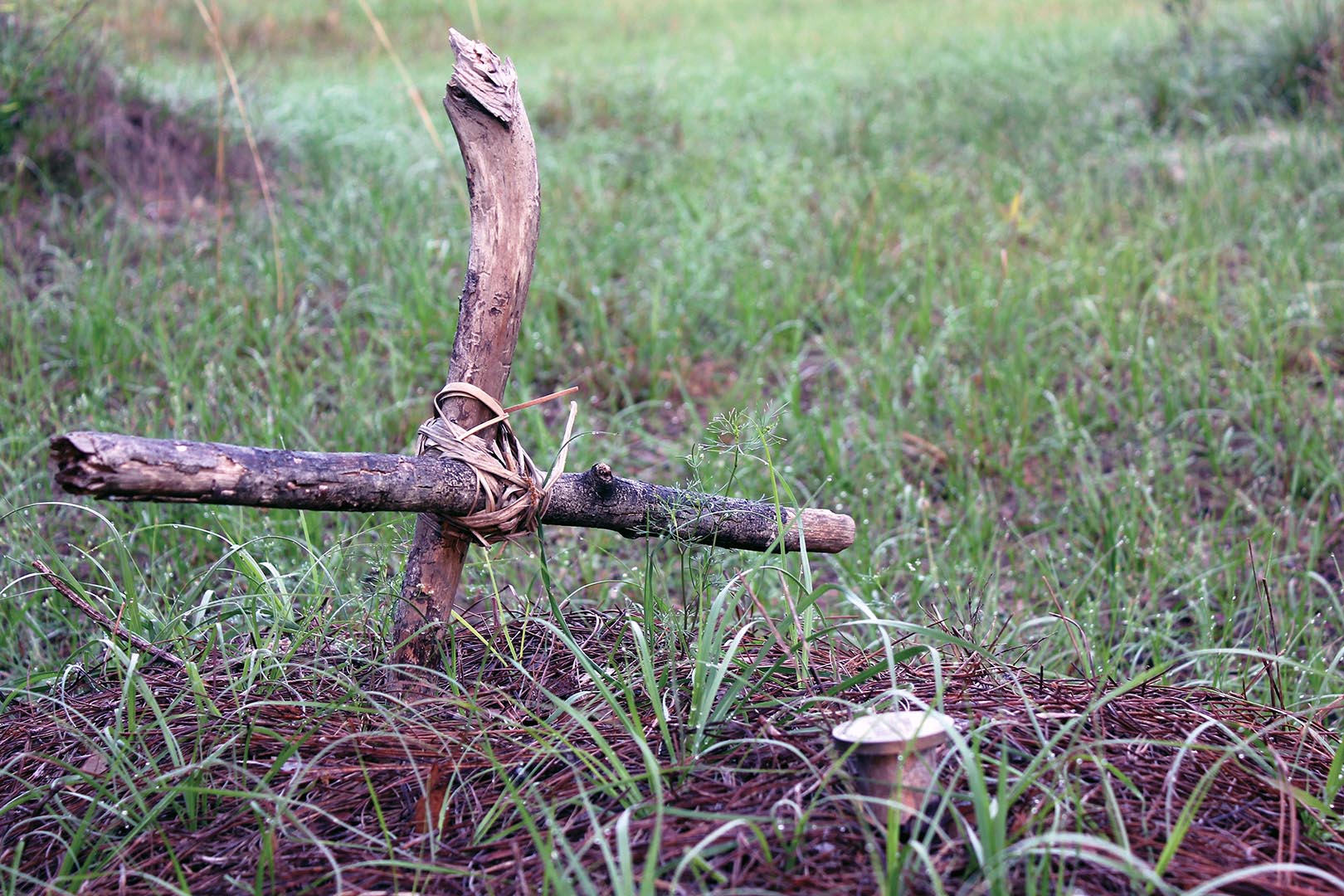
February 7, 2025 | story by Kate Becker
photos by Kate Becker and Elise Plunk
This story is from Atrium’s Winter 2024 magazine, which released December 2024.
Corrections note: An earlier version of this story from our Winter 2024 print issue misstated Prairie Creek Conservation Cemetery’s size, certification status in Florida, expansion plans and ownership. Another earlier version misstated the name of Larry Evans as Larry McKay. These errors have been corrected and are listed at the bottom of the story.
A sprinkle of droplets lands with a splat, splat, splat, signaling the start of Florida’s rainy season. The scent of sod floats through the damp air as dragonflies dive for cover and blades of grass sway and tangle, gusts of wind whisk through curly clumps of moss hanging from oak trees.
April Zee, 25, navigates a gravel path between an open meadow and a thick forest. She steps off the path into tall grasses where scattered mounds of dirt peek up at her from the ground.
On one pile of upturned soil, adorned with wilting flowers, a small, round disk reads “Jose Enrique Vasquez, Aug. 21, 1950 to Oct. 13, 2023.”
It’s a grave.
Without seeing the flash of the brass marker, it’s hard to tell the vast, leaf-covered grounds double as a graveyard. But as assistant director of the Prairie Creek Conservation Cemetery, Zee knows that’s the goal of green burial sites like this one. This resting place is the only certified conservation cemetery in Florida, burying bodies with a focus on environmental sustainability. To do so, cemeteries such as Prairie Creek — comprising 93 acres of Gainesville woodland — entomb the deceased in biodegradable containers and permit only natural mementos, like flowers or rocks, in place of traditional gravestones. They also prohibit the use of embalming fluids like formaldehyde so that decomposition occurs unhindered.
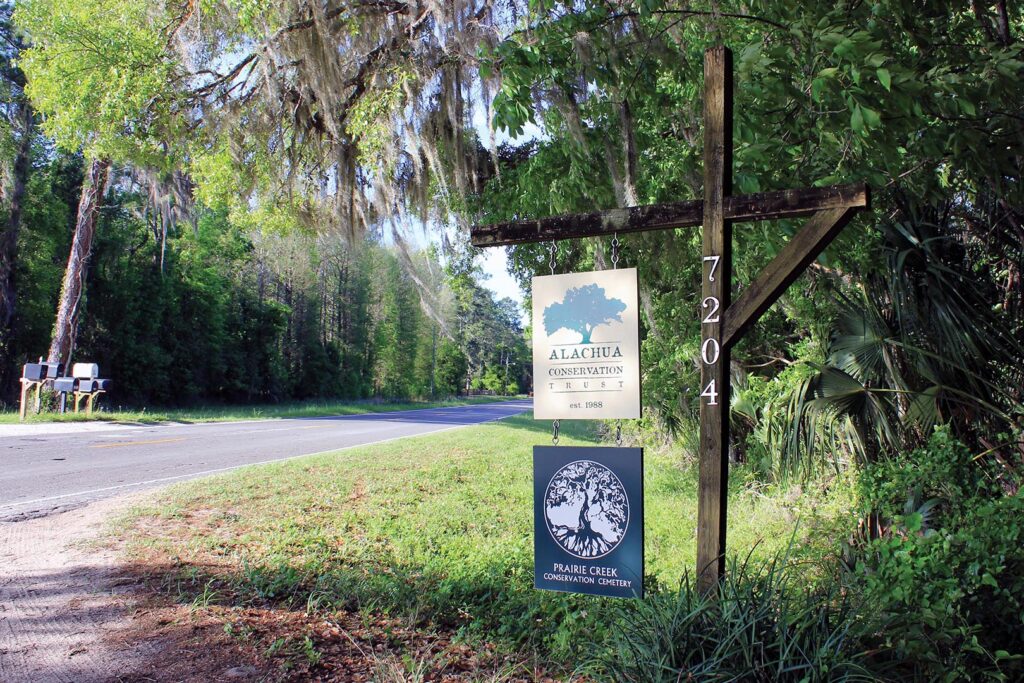
Zee’s brown, weathered boots create a jarring crunch as she cuts through the meadow.
At the cemetery, she works with three others to weed sweet gum trees and use grass to plug patches of dirt. The team’s work is an effort to restore the area back to its natural state, where about 1,100 people currently rest for eternity. Prairie Creek staff must balance their stewardship of the land, including being mindful of the graveyard’s future, while delicately navigating the emotional task of comforting grievers.
An April morning finds Zee and a few volunteers deep in the dense forest, preparing a dig site for a funeral procession and burial scheduled later that week. Laying down a wooden template for the size of the grave, they begin digging into the loam.
Metal shovels slice into the dirt that will be placed atop the person buried here two days later. Roots crunch and crack as volunteer Monelle McKay, 59, clips them away to create a smooth rectangle 42 inches deep.
McKay lost her husband in January, well after she started volunteering at Prairie Creek. She knew she wanted to be buried here and, because of that, he did, too. She remembers Larry Evans’ burial with both contentment and a sense of healing.
Monelle McKay’s family and friends knew they’d be unable to use non-biodegradable caskets or store-bought flower arrangements, abiding by the cemetery’s guidelines. Her neighbor crafted a flower bouquet without any floral foam, weaving each flower together. Her sister quilted a blanket in which they laid Larry to rest. Monelle marked the grave with a large piece of driftwood — a makeshift headstone Larry found on St. George Island years prior.
“When I saw it — oh my God, it was beautiful,” McKay says. “When they took his body from the funeral home onto the procession cart, two eagles flew overhead. It was really, really special.”
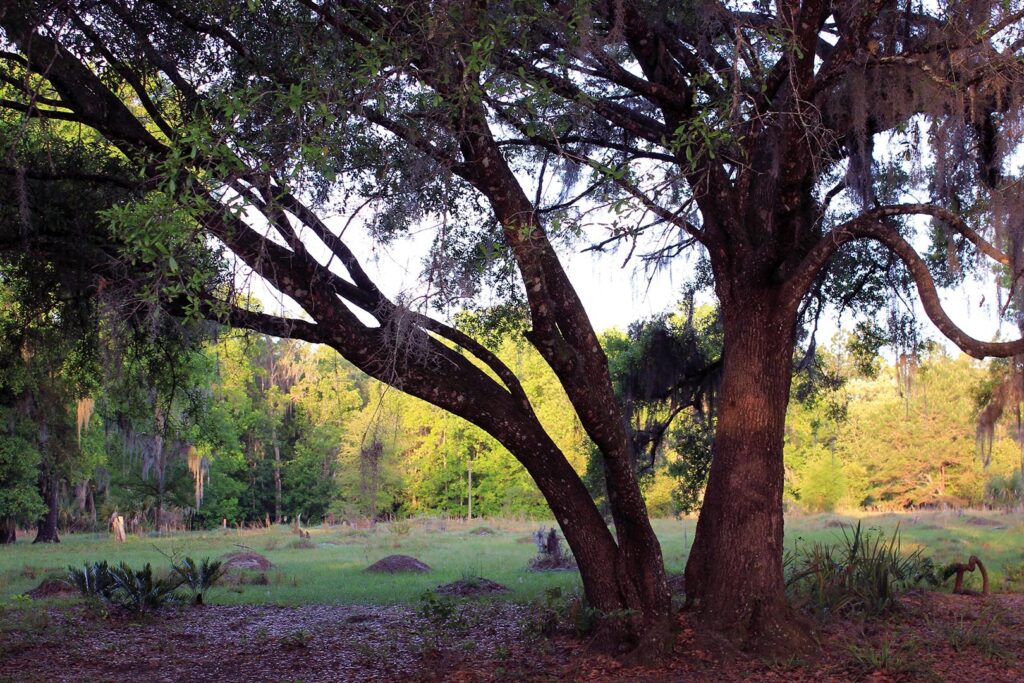
Zee says it was one of the most memorable burials she has been a part of.
Using a tarp to cover the fully hollowed gravesite, she and her team collect their tools and walk out of the forest, the sun a little lower than before. They’re tired and ready to head home.
McKay lingers, walking over to a sunny spot in the tall grass where Larry lies. About 10 feet away, a white marker pokes straight up like the grass. One day, McKay plans to be buried exactly where she stands, close to her husband.
The demand for sustainable burials is growing. While McKay’s spot is reserved, the cemetery will one day run out of space for others. Once it does, Prairie Creek may expand green burials to other locations.
By August, the mornings grow so hot that Zee’s T-shirt — her second of the day — is soaked within the first two hours of daylight. The olive green fabric clings to her body like Saran wrap as she inspects each grave, pausing to read the names of the deceased aloud to keep their memory alive.
“Hello, Kathleen,” she says, as she kneels at a grave flatter than the others. She brushes leaves away from the brass marker.
Kathleen Cantwell, who died in 2010, was a founder of Prairie Creek and the first to be buried in the cemetery. Her cat, Pogie, lies buried at her feet.
“You don’t know if anyone’s said ‘Hello,’ to them in the past year or two,” Zee says.
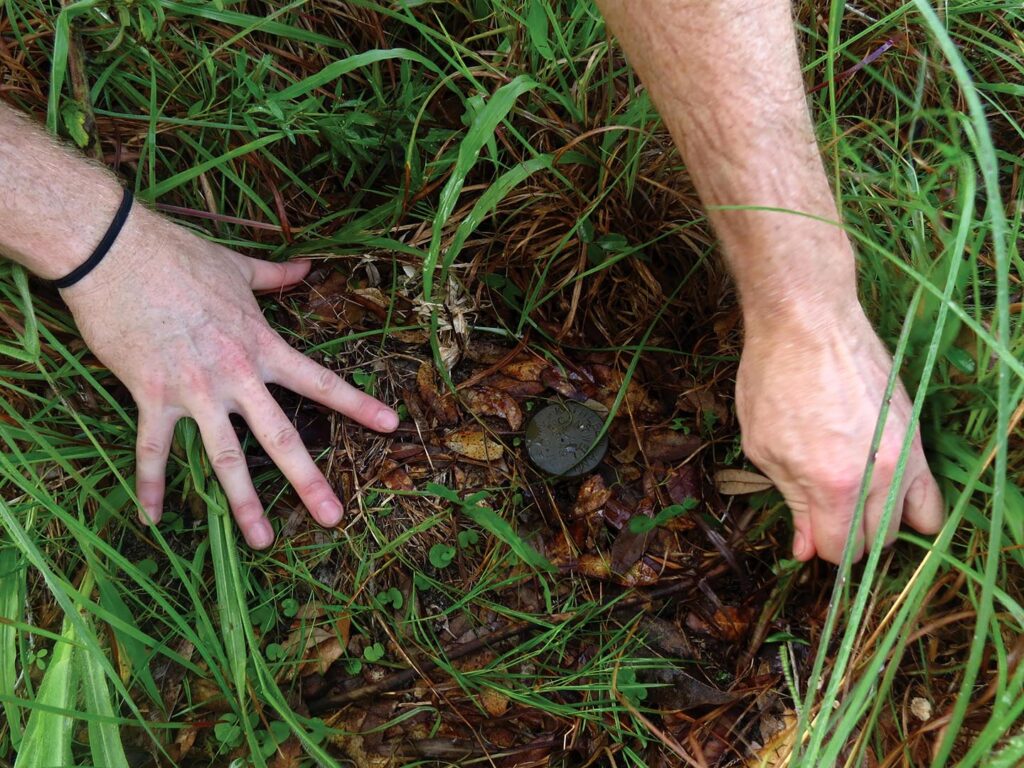
Walking back to the staff golf cart, she inks a check mark next to Cantwell’s name.
“It’s an honest day’s work if I’ve ever heard of one,” she says. “It’s just so cool for me to see the relief of everyone that comes out here. It’s not that you are just burying someone naturally — you are creating a whole new experience for people.”
Zee studied forest resources and conservation at the University of Florida before beginning a research career. But as someone who enjoys interacting with people, she wanted a more hands-on job.
Here, she aids families and friends mourning the loss of their loved ones. It’s an emotional process.
Just weeks prior, she walked a family through the cemetery as they selected a burial site for their deceased relative. The silence was palpable. She chose to stay quiet, too, letting them take their surroundings in, mentioning the beauty of the trees that day.
One of the family members who had spoken the least chimed in to agree. Soon, more of the family felt comfortable speaking with Zee until the group broke finally into laughter.
Zee lights up thinking about it now, and her speech quickens.
“I leave almost every day feeling kind of energized, which is surprising with the kind of work we do out here,” she says. “I think it’s the innate goodness that makes it easy to want to come back.”
A slight chill fills the air, heralding one of the first cold days of fall. The sound of jazz fills the cemetery as families sit in lawn chairs near loved ones’ graves, enjoying the rare lack of Florida heat. Some work with volunteers and staff to finish digging holes for the various native trees and shrubs waiting to be planted. The greenery will serve as living memorials for those who have passed and reintroduce species that used to be in the ecosystem.
An American History of Preserving Bodies
Conventional cemetery practices in the U.S. originated during the Civil War. The bodies of dead soldiers often took a long time to arrive home, so embalmers preserved, restored and sterilized them with chemicals. The goal was to reduce the need for a hasty burial, allowing time for funeral processions and reducing the risk of disease.
Still in use today, the chemicals that are most effective for preservation are the most toxic. Formaldehyde is the main substance used for embalming bodies. According to researchers, the chemical renders human tissue unusable to the bacteria that would naturally break it down into fertile soil. Formaldehyde and other embalming chemicals also leach into the ground during this process, polluting it.
The event is nearly over when a car pulls up. Two women, one holding a baby, emerge.
Despite their late arrival, Zee drives them to the grave they’re looking to visit: a sunny spot of the forest where the older woman’s husband lies. They clear space in the soil for her chosen plants, an azalea bush and a silver buckthorn tree, while Zee carries the infant.
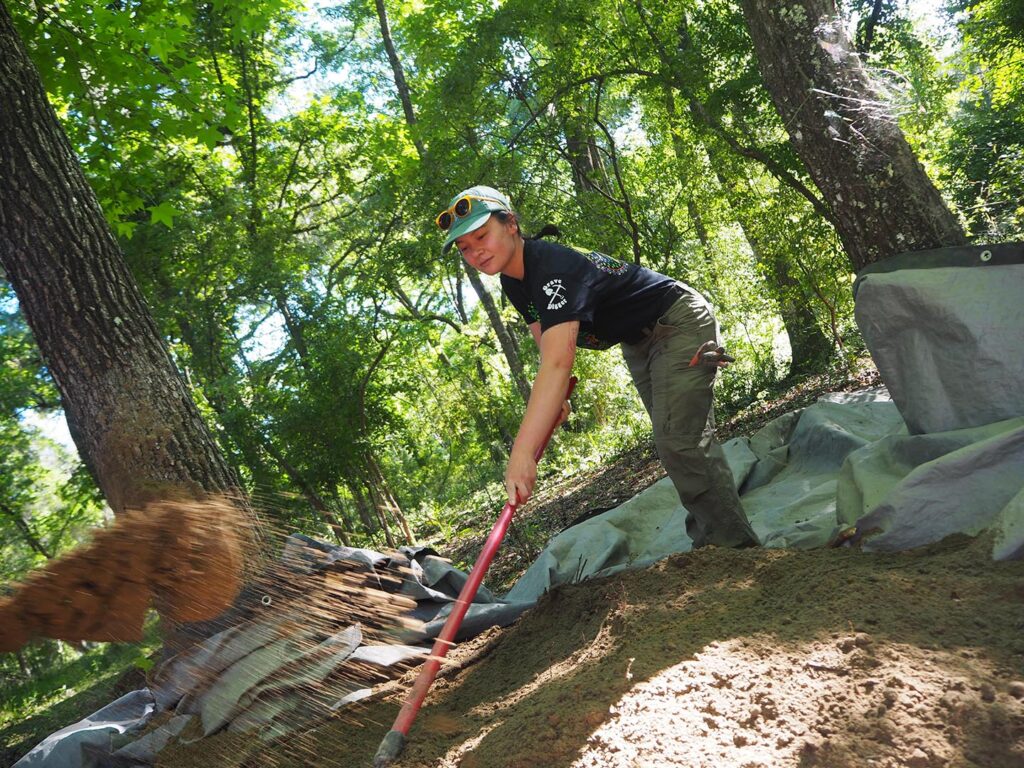
The child, a baby girl, is just beginning to grow hair on her head. Zee looks at her as laughter carries from the families eating and chatting, adorning the graves of those she helped bury months before.
Something shifts in Zee: She is overcome by the full cycle of life unfolding in front of her.
The woman kneels to plant an azalea bush on her late husband’s grave. It will bloom with bright pink flowers in late February.
This story was corrected to state that Prairie Creek Conservation Cemetery is 93 acres, is the only certified conservation cemetery in Florida and has not confirmed plans to relocate to another site in Florida. The print version of this story incorrectly reported that Prairie Creek Conservation Cemetery is 25 acres, one of three certified conservation cemeteries in Florida, may move to a new site in the state and may have its land turned over to the Alachua Conservation Trust. The trust already owns the land.